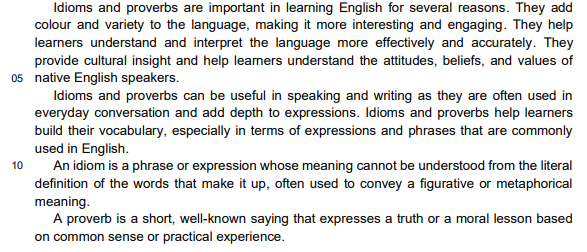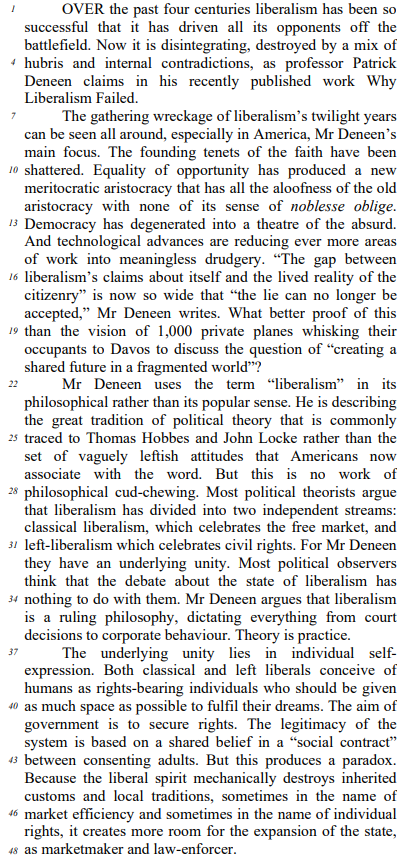Questões de Concurso
Sobre análise sintática | syntax parsing em inglês
Foram encontradas 259 questões
Text 03 – Idioms and proverbs

I. In: ‘Those around her understand her, at least most of the time.’, the repetition of her is necessary, since ‘those around her’ occupies the place of the subject in the sentence, while the other ‘her’ is the indirect object.
II. In: ‘The Silver Spring, Md., resident is the kind of young Hispanic voter attracting increasing attention from political operatives.’, the ‘Md.’ inserted between The Silver Spring and resident breaks syntax order by separating its nominal group.
Choose the CORRECT answer:
In which of the following sentences is the bold word “traveling” the object of the verb?
In which of the following sentences the bold word is used as the subject?
O texto seguinte servirá de base para responder às questões de 21 a 25.
PUCKER UP I'm a dermatologist - you've been using lip balm all wrong - here's why your pout is still chapped
(1º§)YOU might be reaching for your lip balm more and more through these winter months. But are your lips still sore and chapped, no matter how much of the stuff you slather on? According to dermatology experts, the type of balm you put on your pout might be more important than the amount.
(2º§)Dr. Mona Gohara, an associate clinical professor of dermatology at the Yale School of Medicine, and Dr. Brendan Camp, a dermatologist at MDCS Dermatology in New York, told TODAY why some lip balms could do more harm than good.
(3º§)To start with, they discussed why your lips might be chapped in the first place. The cold weather can wreak havoc on them as the skin is very thin, so they're more likely to dry out, Dr Gohara said. Meanwhile, Dr Camp noted that the delicate skin of your pout can easily be irritated by ingredients in skincare or food, yeast or bacteria, and even enzymes in saliva.
(4º§)You might also not be giving them enough love: lot's of people forget about their lips when they're moisturising their face. But if your lips are dry and chapped not long after you apply your balm, you just might be using the wrong kind.
(5º§)Four things to avoid in a lip balm:
1.Tingly balms
2. Fragrances
3. Flavouring agents
4. Dyes
(6º§)Dr Camp said these might cause allergic contact dermatitis, a type of eczema triggered by contact with a particular substance. And if your lips are dry, cracked, red, scaly and itchy, you might have developed a sensitivity to an ingredient in your lip balm, he added. Moral of the story, check your lip balm ingredients.
(7º§)Since you're doing that, there are a few ingredients that will help hydrate your pout. Dr Camp said you want to look for ingredients that will help trap water in the skin while keeping it moisturized for a long period of time. "Ingredients like beeswax, olive oil, castor oil, coconut oil, and shea butter are often used for this purpose," he said.
(8º§)You should also be wearing a salve with SPF to protect your lips from the sun. Meanwhile, Dr Gohara said that your ideal balm will have a combination of humectants (like hyaluronic acid and glycerin), which draw moisture into the skin, and occlusives (such as shea butter and mineral oil), which lock moisture in.
(9º§)The NHS recommended you use one containing petroleum jelly or beeswax. It said: "Try a few different lip balms if one is not working for you - some people may be sensitive to some fragrances, dyes or cosmetic ingredients."
(10º§)As long as you're using the right type of balm, Dr Gohara said you can apply it multiple times a day. According to Dr Camp, it's best to put on lip balm once in the morning and once before bed. There are other ways of preventing dry lips too.
(11º§)Lisa Borg, skin specialist and nutritionist at the Pulse Light Clinc, said the best thing you can do is drink plenty of fluids throughout the day. Preferably quality water as opposed to dehydrating coffee and fizzy drinks, she noted.
(12º§)Lisa also recommended eating foods that simulate saliva production, such as apples, cucumbers, tomatoes, courgettes, watermelon, lemons, and crunchy fibrous vegetables like carrots and celery. Meanwhile, the NHS said you should wash your hands before applying lip balm and cover your lips with a scarf when you're outside in cold weather. If you're outdoors, use a balm with SPF 15 or more every two hours, it added.
(13º§)Common causes of dry lips: cold weather, dry air or wind; damage from the sun; dehydration; a lip injury; allergies; and lack of vitamins and minerals. If you have sore or dry lips, you should avoid: picking or biting any flaky skin on your lips - this can slow down healing; licking dry or cracked lips - this can make them sore; and sharing lip balms with other people - this can spread germs.
(adapted) -wwrongg-pu--chappeed .uk/health/21661055/dermatologist-using-lip-balm-wrong-pout-chapped/
Which of the following options correctly identifies the grammatical function of "licking dry or cracked lips" (13º paragraph) in the given text?
Text to answer the question.

In: Political thought: the problem with liberalism.
The Economist, Edição impressa, p. 74, 27 jan. 2018.
As far as grammar is concerned, mark the statements below as right (C) or wrong (E).
The referent of the word “them” (line 34) is “civil rights”
(line 31).
Text to answer the question.

In: Political thought: the problem with liberalism.
The Economist, Edição impressa, p. 74, 27 jan. 2018.
As far as grammar is concerned, mark the statements below as right (C) or wrong (E).
The word “this” (line 18) refers to “lie” (line 17).
Select the correct alternative.
According to text 1A1-II, judge the following item.
The excerpt “without a voice on issues related to the region”
(first sentence of the third paragraph), could be correctly
replaced by “that lacks representation in matters pertaining
to the region”, without changing its meaning.
According to text 1A1-II, judge the following item.
The first Brazilian expedition to the Arctic, as presented in
the first paragraph, has a threefold objective.

Internet: <comicskingdom.com/>.
Judge the item below according to the previous comic strip.
The expression “Bear in mind” (third box) is a synonym of
overlook.
Julgue o item que se segue.
The sentence “Are these sneakers her’s?” is grammatically correct.
Julgue o item que se segue.
In the sentence “Actually, I don’t know him”, the word
“actually” could be replaced by “currently” without
changing the meaning of the sentence.

